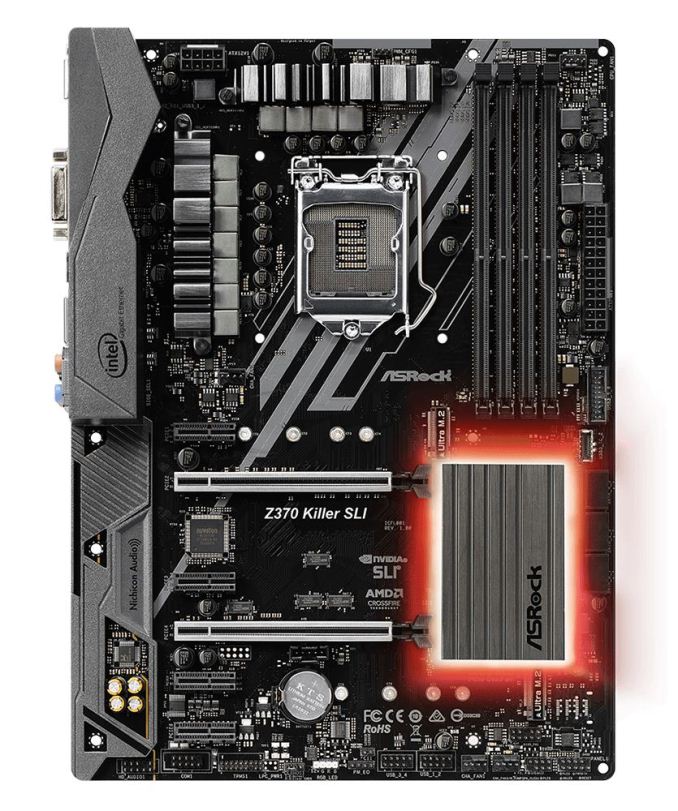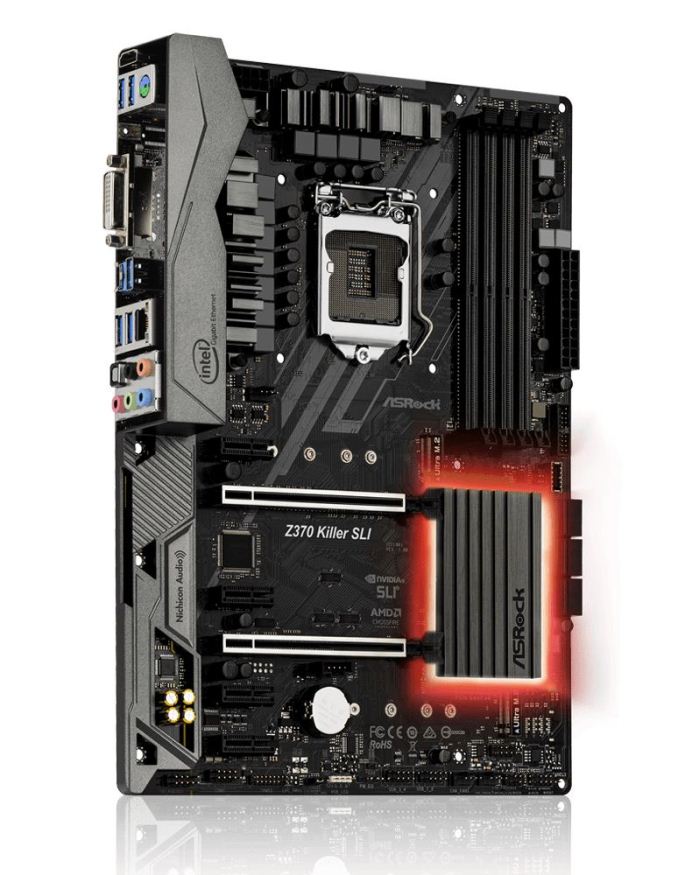Analyzing Z370 for Intel's 8th Generation Coffee Lake: A Quick Look at 50+ Motherboards
by Ian Cutress, Anton Shilov, Joe Shields & Gavin Bonshor on October 20, 2017 2:00 PM ESTASRock Z370 Killer SLI and Killer SLI AC
The ASRock Z370 Extreme line consists of the Z370 Killer SLI/ac, Killer SLI, and the Extreme4. Both of the Killer SLI boards will be covered on this page as the only difference between the two is the wireless LAN which comes with the SLI/ac. Some of the differences between the Gaming line and the Extreme line are the power delivery, different controllers/caps/chokes, different heatsinks, and controller choice allowing for cost-saving efforts to keep the price to the consumer lower than the Gaming or Professional branded motherboards.
Both the Killer SLI and SLI/ac look exactly the same outside of the back panel IO where the ac model has the Intel Wi-Fi card out back. The shared board otherwise is an all-black affair, outside of some artwork on the PCB going through the socket area. The chipset heatsink is more of a simple rectangle on the Killer boards compared to the Gaming boards, and has RGB LEDs below it. An RGB header is located on the bottom of the boards for adding another LED strip. Shrouding covers the back panel and audio sections, while the last design aesthetic that sticks out is the two full-length reinforced PCIe slots.
The four memory slots support the platform maximum of 64 GB, with supported speeds up to DDR4-4266. That value is still faster than most boards covered in the roundup, but one notch below the high-end ASRock boards. There are two full-length reinforced slots fed from the CPU, capable of x16 and x8/x8 connectivity, and four x1 slots from the chipset. Both 2-way SLI and 3-way Crossfire are supported (as well as quad SLI/Crossfire with dual GPUs).
The Killer SLI and SLI/ac both include six SATA ports supporting RAID 0, 1, 5, and 10. Additional storage is handled by two M.2 slots; the first is located above the top full-length PCIe slot and supports drives up to 80mm, while the second is located towards the bottom of the board below the chipset heatsink and supports drives up to 110mm. Be aware of slot sharing; if the first M.2 slot is occupied by a SATA device, SATA5 will be disabled, while if the second M.2 slot is occupied by a SATA module, SATA0 will be disabled.
Fan control is handled through the BIOS or via the F-Stream software, and gives control to all the fan headers: a CPU fan header (1A/12W), two chassis Fan headers, and a chassis optional/water pump header (1.5A/18W). Audio duties are handled by the last generation ALC892 codec, but is upgraded with the use of Nichicon Gold series audio caps. Network connectivity is handled by a single Intel I219-V on both boards with the SLI/ac adding the Intel Wi-Fi module for wireless support. The online specifications do not state which Wi-Fi module this is, although it is likely to be the AC3165.
USB connectivity is the same on both boards with neither utilizing the USB 3.1 (10 Gbps) controllers. On the back panel there are five USB 3.1 (5 Gbps) ports and one Type-C port. Additionally, there are two internal USB 2.0 headers supporting four ports, and another internal USB 3.1 (5 Gbps) header yielding two more ports. All USB ports are handled by the chipset. The back panel IO also has two video outputs with an HDMI and DVI-D port, as well as a 5 plug audio stack plus SPDIF. The Killer SLI/ac is the one with the Intel Wi-Fi antenna ports out back as well.















83 Comments
View All Comments
sor - Friday, October 20, 2017 - link
Damn. At least key it differently and call it LGA1151v2 or something.The changes are so minimal it really does seem like planned obsolescence. Does it really need more power pins to support new chips with the same power envelopes? Really? They couldn’t handle that on the CPU PCB?
KaarlisK - Saturday, October 21, 2017 - link
Actually it is ~1.5 times peak current with the same average power envelope, so yes, they need the change.If they had not brought the launch forward and just launched together with the cheap chipsets, there would be far less complaints.
sor - Saturday, October 21, 2017 - link
Where did you find information indicating current has increased 50%? I just spent about ten minutes trying to find a reference backing that up, perhaps something indicating the 8 series operates at a much lower voltage within same TDP, which would translate to higher current but they seem to operate in the same 1.2-1.3v range.You’re not just assuming they draw more current because they have two more cores, are you?
KaarlisK - Sunday, October 22, 2017 - link
Notice the difference between average and peak.And the information is in publicly available documents. I did not bother to look it up, but others have, for example: https://forum.beyond3d.com/threads/intel-coffee-la...
Crono - Saturday, October 21, 2017 - link
Nice roundup. That's a lot of motherboards to spec and summarize. I especially appreciate the handy chart at the end, it's a good, quick-and-dirty comparison tool.Landcross - Saturday, October 21, 2017 - link
You guys forgot 2 new Z370 boards from Supermicro :)https://motherboarddb.com/motherboards/?chipset=19...
Xpl1c1t - Sunday, October 22, 2017 - link
The mITX board looks incredible.+ Low ESR Tantalum capacitors! (first time seeing them on VRM duty on a mainboard)
+ HDMI 2.0
+ 2x M.2 Slots
+ USB 3.1 Type C
+ Optical SPDIF
- RGB.......
MadAd - Saturday, October 21, 2017 - link
Great write up but for me its just another depressing generation of oversized, overpriced ATX form factor offerings on which the vast majority of users wont even plug a second gpu into, with the smaller and more size appropriate FF represented as a minority afterthought.With all the progress of PCs since the 90s whod have thought that I could still use the same ATX case today while every single other component (from floppy drives to 2d Mattrox cards) have long gone to the recyclers. I find it so annoying how manufacturers have stuck on this prehistoric gargantuan case size with the other sizes being an afterthought. It feels like like stifled innovation while everything else is moving on.
rocky12345 - Saturday, October 21, 2017 - link
Great article and a lot of work put in to get it out for us to read thank you.My only issue is and it is nit your fault is why these companies feel the need to totally blanket the market with basically the same boards just a different model number and basically a few tiny changes and spray paint it a different color and use the word gaming and put something x or x1 or k,k3 etc etc. For crap sakes just release three models not 7-10 models of the same crap it is pretty much just greed I guess.
The whole market is like this now with anything computer related of and if it has the words GAMING or RGB in it's got to be good for sure. My fav is that gaming mouse pad next it will have RGB lighting in it...lol
CitizenZer0 - Wednesday, October 25, 2017 - link
Agreed